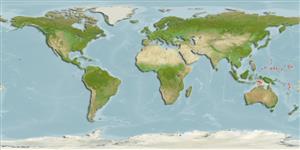Common names from other countries
>
Kurtiformes (Nurseryfishes, cardinalfishes.) >
Apogonidae (Cardinalfishes) > Apogoninae
Etymology: luteus: From the Latin for yellow in reference to its yellow coloration in life (Ref. 33415).
More on authors: Randall & Kulbicki.
Environment: milieu / climate zone / depth range / distribution range
Ecologia
marinhas associadas(os) a recifes; intervalo de profundidade 1 - 49 m (Ref. 37816). Tropical
Western Central Pacific: Philippines to the Marshall Islands.
Tamanho / Peso / Idade
Maturity: Lm ? range ? - ? cm
Max length : 4.4 cm SL macho/indeterminado; (Ref. 33415)
Descrição breve
Chaves de identificação | Morfologia | Morfometria
Espinhos dorsais (total) : 8; Raios dorsais moles (total) : 9; Espinhos anais: 2; Raios anais moles: 8; Vértebras: 24. Predorsal scales 4; preopercular edge serrate; preopercular ridge smooth to slightly crenulate; body depth 2.9-3.3 in SL; yellow with six narrow blue stripes on head, the two upper stripes usually continue faintly as broader purplish stripes on body; a blue-edged yellow stripe basally in second dorsal and anal fins; dorsal profile of head slightly convex (Ref. 33415).
Inhabits sheltered clearwater areas of lagoon and seaward reefs. Aggregates under ledges, in holes, or even among spines of sea urchins. Feeds on planktonic crustaceans and small invertebrates by day and night (Ref. 37816).
Life cycle and mating behavior
Maturities | Reprodução | Spawnings | Egg(s) | Fecundities | Larvas
A mouth-brooder. Distinct pairing during courtship and spawning (Ref. 205).
Myers, R.F., 1999. Micronesian reef fishes: a comprehensive guide to the coral reef fishes of Micronesia, 3rd revised and expanded edition. Coral Graphics, Barrigada, Guam. 330 p. (Ref. 37816)
Categoria na Lista Vermelha da IUCN (Ref. 130435)
CITES (Ref. 128078)
Not Evaluated
Ameaça para o homem
Harmless
Utilização humana
Ferramentas
Relatórios especiais
Descarregue XML
Fontes da internet
Estimates based on models
Preferred temperature (Ref.
115969): 28.1 - 29.1, mean 28.5 (based on 20 cells).
Phylogenetic diversity index (Ref.
82804): PD
50 = 0.5000 [Uniqueness, from 0.5 = low to 2.0 = high].
Bayesian length-weight: a=0.01122 (0.00528 - 0.02384), b=3.10 (2.92 - 3.28), in cm Total Length, based on LWR estimates for this (Sub)family-body shape (Ref.
93245).
Nível Trófico (Ref.
69278): 3.5 ±0.49 se; based on food items.
Resiliência (Ref.
120179): Elevada, tempo mínimo de duplicação da população menor que 15 meses (Preliminary K or Fecundity.).
Fishing Vulnerability (Ref.
59153): Low vulnerability (10 of 100).
